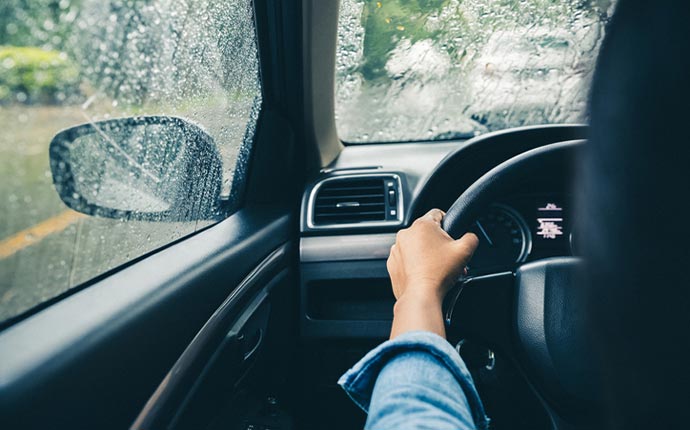Summer is officially over, which means cooler weather is fast approaching. And in California, that means rain. In the Golden State, our rainy season runs between November and March, with winter typically being the wettest time of year. Unfortunately, this is also when we tend to see an increase in accidents due to wet roads.
Following safe driving practices is crucial when roads become slick from heavy rain. Here are a few tips to follow when driving in the rain to prepare for the coming weather.
1. Slow Down
When driving in unfavorable weather conditions, the first precautionary step to take is slowing down. Although it may be tempting to speed down the highway if you’re late for work, doing so can be extremely dangerous. Speeding on wet roads increases the chances of losing control of your vehicle and causing an accident.
Additionally, it isn’t recommended to use cruise control during wet weather. While it may sound like a good idea to maintain your reduced speed, it’s best to have complete control of your car while it’s raining. Your car’s systems may not be able to identify a hydroplane situation and, as a result, may continue to accelerate despite the hazards.
2. Check Traffic and Road Conditions Ahead of Time
It’s safe to assume that there will be traffic delays anytime it rains in California, especially for those living in large cities. So, to keep you from being late, it’s best to check road conditions and plan accordingly. Following resources such as CalTrans in CA on social media can help you stay updated on the latest information regarding road conditions.
As previously mentioned, speeding on wet roads is a recipe for disaster. Therefore, if you must drive during a rainstorm, plan to leave earlier than you usually would to prevent any unnecessary urge to speed.
3. Keep Your Distance
Tailgating is always dangerous, but its danger increases whenever roads are wet. If you’re driving too close to the car in front of you, you’ll have little to no time to react to sudden changes in speed. In these situations, slamming the brakes could cause your car to skid on wet roads.
Rainfall reduces visibility, making it difficult to see any upcoming hazards, so giving yourself enough time to react is important. Always keep ample distance between you and the car ahead of you when driving in bad weather. If possible, keep an open space on at least one side of your vehicle. That way, should you need to react quickly, you have an area to merge into.
4. Make Sure Your Car Is in Good Condition
Since rain affects your visibility when driving, it’s vital that your car doesn’t add to the problem. So before a rainstorm, be sure to prioritize any repairs that impede your ability to see. Replacing broken glass, installing new windshield wipers, and ensuring your lights are working are crucial any time of the year, but especially during bad weather.
We recommend spending time every week to do a quick overall vehicle inspection. Rain or shine, staying on top of your car’s condition can help you save on repairs in the long run by catching any issues as soon as they appear. Once a week, check your car’s headlights, taillights, wipers, and tire treads to get a quick rundown of your car’s health. If your car has automatic lights, it can be easy to miss when a light goes out.
5. Eliminate Distractions
Whenever driving in poor weather conditions, it’s essential to keep your eyes and focus on the road. If it’s raining and you have to go someplace new, consider planning your route ahead of time. That way, you won’t have to rely on mapping apps as much to get you where you need to go.
By eliminating distractions, you also make it easier to spot any unexpected hazards. For example, vehicles parked on the side of the road, emergency vehicles, and maintenance signs are normal sights during a rainstorm that may be harder to see.
6. Be Visible
When driving in low visibility conditions, be sure you are visible to other drivers on the road. This means always driving with your headlights on to let cars know you’re there. Your vehicle settings may automatically turn your car’s lights on for you. If so, it’s still a good idea to double-check they’re on before heading out.
Never drive with your bright lights on during a rainstorm. The bright light will reflect off the water and other surfaces, which can irritate your eyes and other drivers.
7. Stay at Home
Road conditions may sometimes be so bad that staying home is best. If your drive isn’t essential, ask yourself if it can be postponed until road conditions improve. That way, you aren’t putting yourself through any unnecessary risks.
Coverage You Can Count On
The easiest way to protect yourself financially from an accident is to have the right auto insurance policy in place. At Orion Indemnity, our business is tailored exclusively for California drivers. We offer our customers a wide range of coverages to meet their specific needs. If you’re looking for a change, our insurance professionals can help you build a policy that works best for you. Call us today at (833) 336-7466 to learn more.
The information in this article is obtained from various sources and is offered for educational purposes. Furthermore, it should not replace manuals or instructions provided by the manufacturer or the advice of a qualified professional. No warranty or appropriateness for a specific purpose is expressed or implied.

